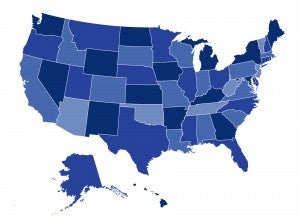
One of the key goals of the Affordable Care Act (ACA) is to make health insurance coverage more affordable and consumer-friendly by managing competition among health insurers through the creation of health insurance exchanges. In order to accomplish this, however, exchanges will first need to be attractive enough to insurers to participate.
Last Friday, the Robert Wood Johnson Foundation released a new report by researchers at the Urban Institute and CHIR that explores state actions to encourage or require participation on exchanges, and early indications of the level of competition among health insurers. The paper focuses on six study states (Colorado, Maryland, New York, Oregon, Rhode Island, and Virginia) that are participating in the Robert Wood Johnson Foundation’s State Health Reform Assistance Network.
While the study states are only now beginning to finish up a multi-month process of certifying insurers and reviewing rates, a number of preliminary findings could be made:
- Most states have adopted mechanisms to require or encourage participation in the exchanges. Maryland was the only study state to require any insurers to participate in the exchange. Other study states established waiting periods to encourage participation in the first year.
- Most states are being accommodating to insurers on certain exchange standards, including network adequacy and service area requirements. The flexibility provided to insurers in these critical areas was cited as an important factor in the level of insurer participation in the exchanges.
- Most states expect a robust number of insurers to participate in the exchanges, including existing commercial insurers and new entrants to the commercial markets such as Medicaid plans, consumer operated and orientated plans (CO-OPs) and, potentially, multi-state plans.
- Most states expect that exchanges will be fairly competitive and there are some early indications that premiums will be reasonable for some plans. For example, in Oregon, recently approved rates suggest that a 40 year old, non–smoker will be able to purchase a silver plan for as low as $215 per month.
Overall, it is expected that that exchanges in most of the study states will launch with a robust level participation and a fair amount of competition that, over time, could lead reasonable priced premiums that benefit both consumers and the federal government.
For more information on this project, including state-specific reports such as the ones featured here, be sure to follow CHIRblog’s “State of the States” series!


2 Trackbacks and Pingbacks